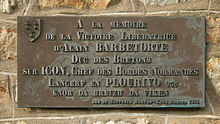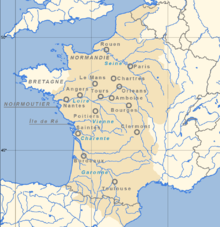Loire Normans
The Normans of the Loire (Loire-Normans, Loire-Vikings) were predominantly Norwegian Vikings who had established themselves at the Loire estuary in the 9th and 10th centuries and were handed down by medieval French chroniclers as Normands de Loire . Just like the predominantly Danish Vikings at the mouth of the Seine ( Seine-Normans , the actual Normans ), they regularly formed large fleets that plagued numerous cities and towns upstream.
Vikings on the Loire
From around 840 onwards, the Loire-Normans had set up permanent winter camps on the Atlantic island of Noirmoutier, south of the river mouth, and Nantes was first plundered in 843. In changing alliances with the Seine-Normans, Bretons and West Franconian (French) regional princes (e.g. Lambert II of Nantes , Pippin II of Aquitaine ), the Loire-Normans repeatedly attacked Angers , Le Mans , Tours and even Orléans in the following decades as well as Bourges . However, the Loire Normans on Noirmoutier 853 or 855 (or 856) were also attacked by Norwegian Vikings from Ireland .
From the Loire Vikings under Björn Eisseite and his brother Hasting 859-862 are said to have even penetrated into the Mediterranean and moved up the Rhone . Occasionally, Norwegian and Danish Vikings raids along the rivers Rhone, Garonne , Charente etc. have made analogous to the Loire Normans and Seine Normans as Rhone-Norman , Gironde -Normannen , Charente-Norman referred etc; often, however, it was also a question of groups that at least temporarily had their base on Noirmoutier. From 845/50 to 865/68 they also had a base in Saintes on the Charente or on the Atlantic island of Île de Ré, which is near the Charente estuary .
Under Hastings leadership and allied with the Bretons, the Loire-Normans defeated the French in the Battle of Brissarthe in 866 and occupied Angers for a year in 872–873, but in 879 they suffered a defeat against the French on the Vienne (tributary of the Loire). From 882 the Loire-Normans moved their base from Noirmoutier to a Loire island directly in front of Nantes, Hasting was taken over by the French King Ludwig III. enfeoffed with the county of Chartres . In 886 the Loire-Normans occupied Nantes and from 887 also ruled West-Brittany, before they suffered setbacks against the Bretons from 888 and lost this city again in 890 after a defeat at Nantes. After that, they also took part in raids and fighting in the British Isles.

Depiction of the battle of the Vienne between the French and the Loire-Normans after Jean Fouquet
|
Vikings in Brittany

From 912 the Loire-Normans under their leaders Ottar , Hroald and Rognvald (Ragnvald, Ragenold, Reinold) began a new invasion of Brittany , in 919 and 920 respectively they conquered Nantes and Rennes . On behalf of King Charles III. Margrave Robert I and Duke Hugo the Great finally had to officially cede the county of Nantes as a fiefdom in 921 and 927 Rognvald - like Charles III. previously (911) had already had to enfeoff the Seine-Normans leader Rollo with Rouen . Under Rögnvald and his successors Felekan († 930 or 931) and Håkon (Inkon, Incon, Icon) , the Loire-Normans not only ruled Nantes for a decade and a half, but also almost all of Brittany, at least its southern half and the Niederlassung or the Breton coast to Cornouaille and some forts in the north (for example Trans-la-Forêt ). A Breton uprising in 931 was initially suppressed with the help of the Seine-Normans, but the alliance between Loire-Normans and Seine-Normans broke up in 935.
In contrast to the Seine-Normans, the Loire-Normans did not succeed in gaining a permanent foothold in the Vendée or Brittany and establishing a “second Normandy ” (“Normandy on the Loire”), ie a long-term, independent dominion and settlement area . Allied with the French, the Bretons rose again in 936 under Alain II and conquered Nantes after the Battle of Saint Aignan in 937 and Rennes after another battle in 938. The last Norman fort in Brittany (Trans-la-Forêt) fell in 939.
The defeated remnants of the Loire Normans joined the Seine Normans; Attacks and raids continued until around 960.
literature
- Georg Bernhard Depping , Friedrich August Wolter: The army journeys of the Normans to their permanent establishment in France. Volume 2. Hoffmann and Campe, Hamburg 1829, pp. 91-97.
- August Friedrich Gfrörer : Pope Gregorius VII and his age. Volume 3. Hürter, Schaffhausen 1859, pp. 140-184.
- Jens Jacob Asmussen Worsaae : The danske conquering of England and Normandy . Gyldendal, Copenhagen 1863, pp. 57 ff., 169-174.
- Walther Vogel : The Normans and the Franconian Empire. Carl Winter, Heidelberg 1906, pp. 61–359.
- Johannes Hoops : Reallexikon der Germanischen Altertumskunde . Forgotten Books, London 1918, pp. 534-539.
- Nicholas Hooper , Matthew Bennett: The Cambridge Illustrated Atlas of Warfare. The Middle Ages (768-1487). Cambridge University Press, Cambridge 1996, pp. 20 ff.
- Theodor Schieder (Hrsg.): Handbook of European history. Volume 1: Europe in the transition from antiquity to the Middle Ages. Klett-Cotta, Stuttgart 1996, pp. 487-490.
- Rudolf Simek : The Vikings . CH Beck, Munich 1998 pp. 34 ff., 59 ff.
- Katherine Holman: The A to Z of the Vikings . Scarecrow Press, Lanham 2009, p. 56 ff.
- Hubert Houben : The Normans . CH Beck, Munich 2012, pp. 10-14.
- Philip Parker: The Northmen's Fury. A History of the Viking World. Random House, New York 2014.
Web links
- Neil S. Price: The Vikings in Brittany ( PDF )
- Penguin Historical Atlas of the Vikings: The Vikings in Brittany
- Crimson's History: The Vikings Of France
- Medieval Wiki: Loire Normans
- Bretagneweb: Histoire de la Bretagne



